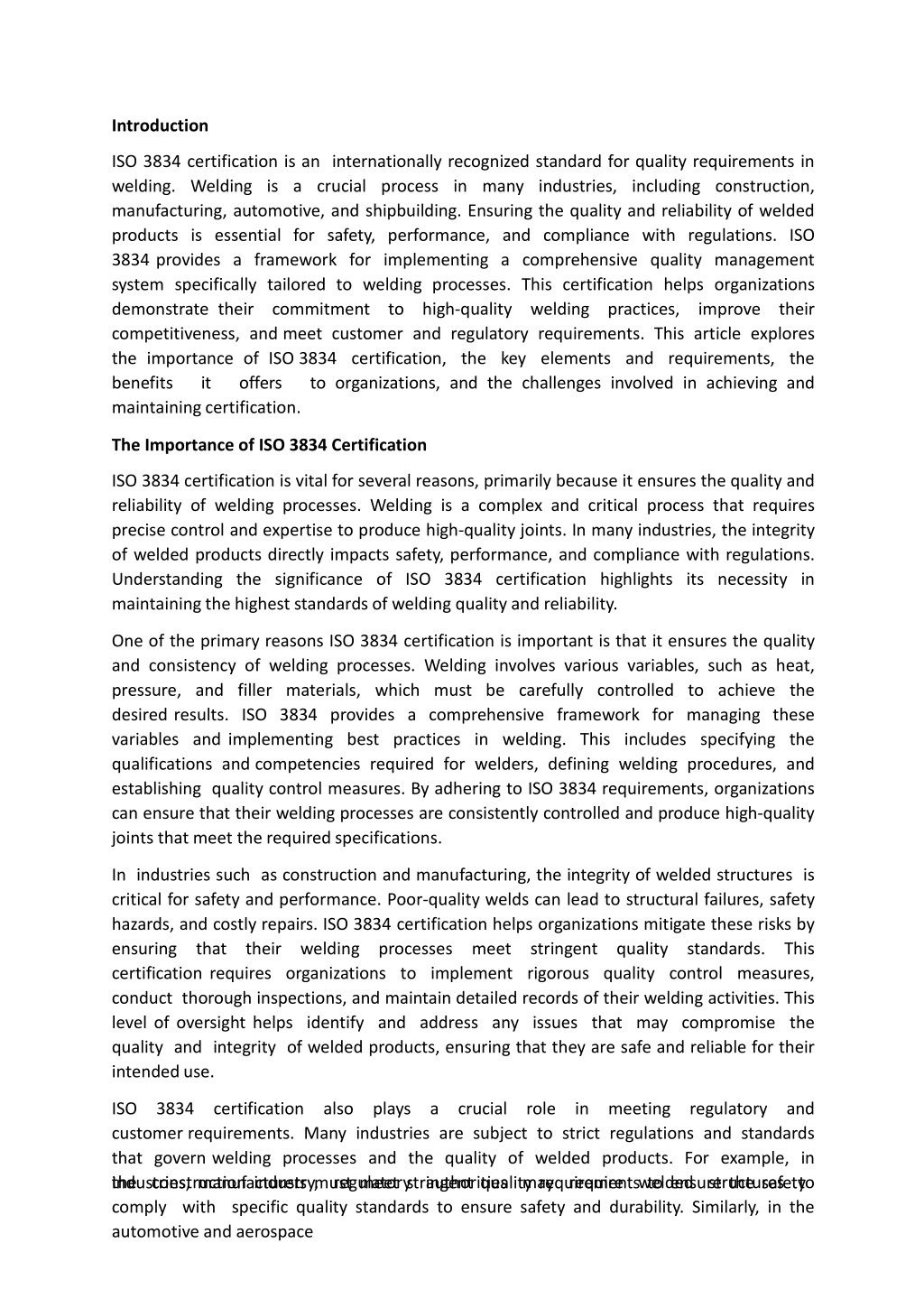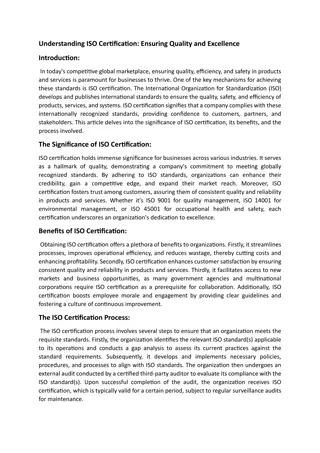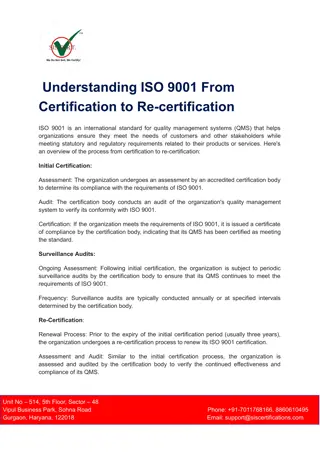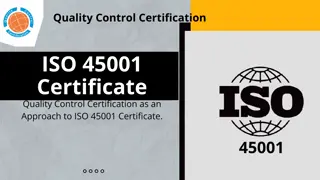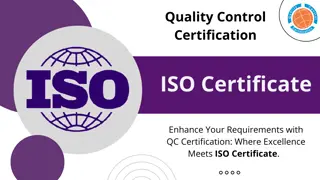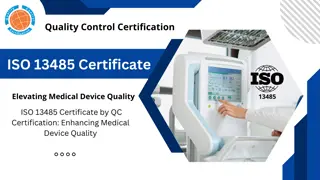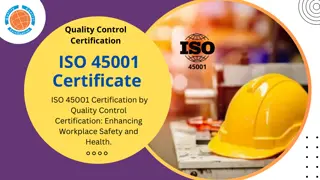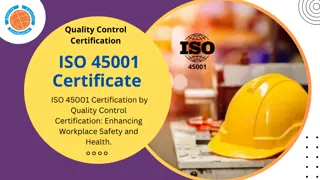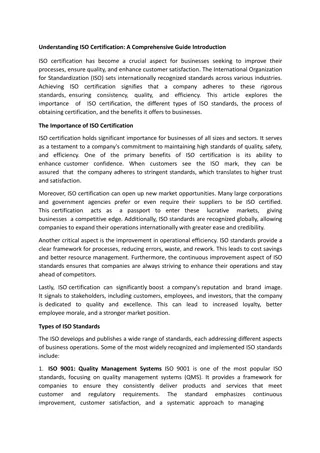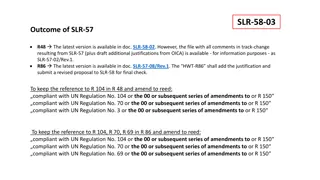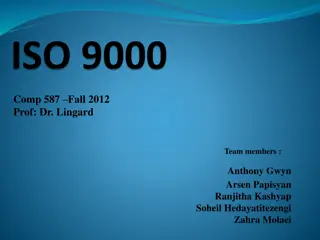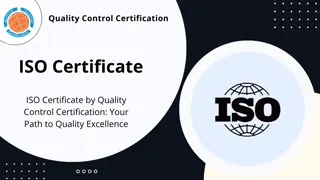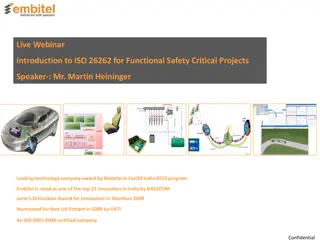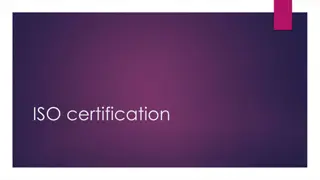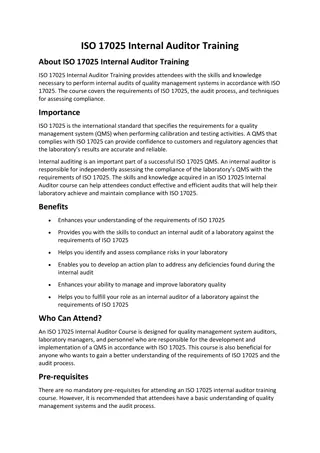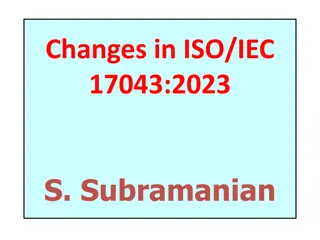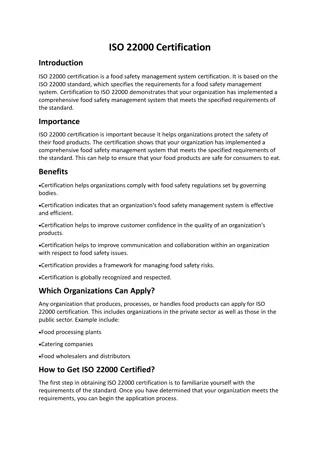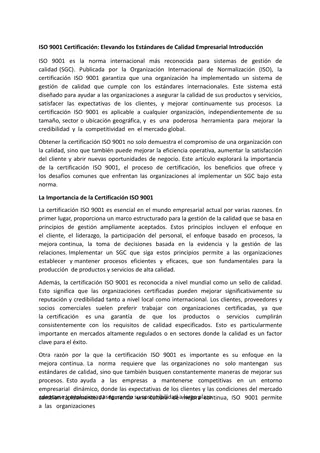certification iso 3834
La norme ISO 3834 du00e9finit les exigences de qualitu00e9 pour le soudage dans les ateliers et les contextes sur site, et elleestimportante pour montrer la capacitu00e9du2019uneentreprise u00e0 cru00e9erune structure soudu00e9e qui ru00e9pon
Download Presentation

Please find below an Image/Link to download the presentation.
The content on the website is provided AS IS for your information and personal use only. It may not be sold, licensed, or shared on other websites without obtaining consent from the author. Download presentation by click this link. If you encounter any issues during the download, it is possible that the publisher has removed the file from their server.
E N D
Presentation Transcript
Introduction ISO 3834 certification is an internationally recognized standard for quality requirements in welding. Welding is a crucial process in many industries, including construction, manufacturing, automotive, and shipbuilding. Ensuring the quality and reliability of welded products is essential for safety, performance, and compliance with regulations. ISO 3834 provides a framework for implementing a comprehensive quality management system specifically tailored to welding processes. This certification helps organizations demonstrate their commitment to high-quality competitiveness, and meet customer and regulatory requirements. This article explores the importance of ISO 3834 certification, the key elements and requirements, the benefits it offers to organizations, and the challenges involved in achieving and maintaining certification. welding practices, improve their The Importance of ISO 3834 Certification ISO 3834 certification is vital for several reasons, primarily because it ensures the quality and reliability of welding processes. Welding is a complex and critical process that requires precise control and expertise to produce high-quality joints. In many industries, the integrity of welded products directly impacts safety, performance, and compliance with regulations. Understanding the significance of ISO 3834 certification highlights its necessity in maintaining the highest standards of welding quality and reliability. One of the primary reasons ISO 3834 certification is important is that it ensures the quality and consistency of welding processes. Welding involves various variables, such as heat, pressure, and filler materials, which must be carefully controlled to achieve the desired results. ISO 3834 provides a comprehensive framework for managing these variables and implementing best practices in welding. This includes specifying the qualifications and competencies required for welders, defining welding procedures, and establishing quality control measures. By adhering to ISO 3834 requirements, organizations can ensure that their welding processes are consistently controlled and produce high-quality joints that meet the requiredspecifications. In industries such as construction and manufacturing, the integrity of welded structures is critical for safety and performance. Poor-quality welds can lead to structural failures, safety hazards, and costly repairs. ISO 3834 certification helps organizations mitigate these risks by ensuring that their welding processes certification requires organizations to implement rigorous quality control measures, conduct thorough inspections, and maintain detailed records of their welding activities. This level of oversight helps identify and address any issues that may compromise the quality and integrity of welded products, ensuring that they are safe and reliable for their intendeduse. meet stringent quality standards. This ISO customer requirements. Many industries are subject to strict regulations and standards that govern welding processes and the quality of welded products. For example, in the construction industry, regulatory authorities may require welded structures to comply with specific quality standards to ensure safety and durability. Similarly, in the automotive and aerospace 3834 certification also plays a crucial role in meeting regulatory and industries, manufacturers must meet stringent quality requirements to ensure the safety
and performance of their products. ISO 3834 certification demonstrates that an organization complies with these requirements, facilitating regulatory approval and customer acceptance. This certification also provides assurance to customers that the organization is committed to delivering high-quality, reliable welded products. Moreover, ISO 3834 certification enhances an organization s competitiveness in the market. In today s globalized economy, customers and partners increasingly demand high- quality products that meet international standards. ISO 3834 certification serves as a mark of quality and reliability, differentiating competitors. This certification can open customers, and enhance the organization s reputation. In industries where quality and safety are paramount, ISO 3834 certification can be a significant competitive advantage, helping organizations win contracts, secure partnerships, and achieve long-term business success. certified new business opportunities, organizations from their attract up Key Elements and Requirements of ISO 3834 Certification Achieving ISO 3834 certification involves meeting a set of stringent requirements designed to ensure the highest standards of welding quality and reliability. These requirements cover various aspects of the welding process, including personnel qualifications, welding procedures, quality control, and documentation. Understanding the key elements and requirements of ISO 3834 certification helps organizations prepare for the certification process and maintain compliance. One of the fundamental elements of ISO 3834 certification is the qualification and competence of welding personnel. Welding is a skilled trade that requires specialized knowledge and expertise. ISO 3834 competencies required for welders, welding operators, and welding inspectors. This includes formal training, certification, and practical experience in welding. Organizations must ensure that their welding personnel meet these requirements and maintain up-to- date qualifications. Regular training and assessments help ensure that welders are knowledgeable about the latest welding techniques, safety practices, and quality standards. By ensuring that welding personnel organizations can achieve consistent, high-qualitywelding results. specifies the qualifications and are qualified and competent, Another and documentation of welding procedures. Welding procedures define the specific techniques, materials, and parameters used in welding processes. ISO 3834 requires organizations to develop and document detailed welding procedure specifications (WPS) for each welding process. These specifications must be based on recognized standards and validated through testing and inspection. The WPS should include information such as the type of welding process, base materials, filler materials, welding positions, and welding parameters (e.g., voltage, current, adhering to these procedures, organizations processes are consistent and controlled, producing high-quality joints that meet the requiredspecifications. certification. ISO 3834 requires organizations to implement rigorous quality control critical requirement of ISO 3834 certification is the establishment travel speed). ensure By documenting that their and can welding Quality 3834 control and inspection are integral to achieving and maintaining ISO
measures at various stages of the welding process. This includes inspecting raw materials, monitoring welding parameters, conducting non-destructive testing (NDT), and performing visual inspections of welded joints. Organizations must establish quality control procedures and maintain detailed records of their inspection and testing activities. Any deviations or non-conformities identified during inspections must be investigated and addressed through corrective actions. Regular internal audits and reviews help ensure that quality control measures are effective and that the organization remains compliant with ISO 3834 requirements. Documentation and record-keeping are essential for ISO 3834 certification. Accurate and detailed documentation provides a record of compliance with ISO 3834 requirements and is crucial for traceability and accountability. Organizations must maintain records of welding personnel qualifications, welding procedures, quality control inspections, and corrective actions. This documentation supports internal audits, regulatory inspections, and customer inquiries. Proper documentation by providing insights into the effectiveness of welding processes and quality control measures. By maintaining comprehensive records, organizations can demonstrate their commitment to quality and compliance with ISO 3834 standards. also facilitates continuous improvement Benefits of ISO 3834 Certification for Organizations ISO 3834 certification offers numerous benefits to organizations, enhancing their operational efficiency, market access, regulatory compliance, and overall reputation. Understanding these benefits can help organizations recognize the value of investing in ISO 3834 certification and motivate them to pursue and maintain this certification. One of the primary benefits of ISO 3834 certification is improved operational efficiency. Implementing ISO 3834 standards robust quality management systems, streamline their welding processes, and eliminate inefficiencies. This leads to better control over the welding process, reducing waste, minimizing errors, and optimizing resource utilization. For example, by implementing rigorous welding procedure specifications and quality control measures, companies can prevent defects and reduce the need for rework and repairs. Improved process control also enhances the consistency and reliability of welded products, resulting in higher product yields and lower production costs. Overall, achieve greater operational efficiency and cost-effectiveness. requires organizations to establish ISO 3834 certification helps companies ISO 3834 certification also facilitates market access and expansion. Many industries require products, particularly welded structures and components, to meet ISO 3834 standards before they can be marketed. ISO 3834 certification demonstrates that a company complies with these regulatory requirements, allowing them to access and compete in global markets. Additionally, ISO 3834 certification is often recognized and valued by customers, partners, and suppliers worldwide. It serves as a mark of quality and reliability, enhancing a company s reputation and credibility. This can open up new business opportunities, attract international customers, and facilitate partnerships with reputableorganizations.
Regulatory Compliance with ISO 3834 standards is often a legal requirement in regulated industries such as construction, automotive, and aerospace. Achieving ISO 3834 certification demonstrates that a company adheres to these regulations and is committed to maintaining high standards of welding quality and safety. This helps companies avoid regulatory penalties, legal liabilities, and product recalls, which can be costly and damaging to their reputation. ISO 3834 inspections and audits, providing evidence of compliance and facilitating a smoother regulatory process. By ensuring compliance with ISO 3834 standards, companies can mitigate risks and maintain their license to operate. compliance is another significant benefit of ISO 3834 certification. certification also supports regulatory Furthermore, Consumers today are increasingly concerned about the quality and safety of the products they use. ISO 3834 certification serves as a visible assurance that a company s welded products are manufactured according to internationally recognized standards. This can build and strengthen customer trust, as they can be confident that the products they purchase are safe, high-quality, and reliable. Enhanced customer trust and satisfaction can lead to increased customer loyalty, positive word-of-mouth, and a stronger brand reputation. In competitive markets, ISO 3834 certification can differentiate a company from its competitors and contribute to long-term business success. ISO 3834 certification enhances customer trust and satisfaction. Challenges in Achieving and Maintaining ISO 3834 Certification While certification iso 3834 offers numerous benefits, achieving and maintaining this certification can be challenging. Organizations must navigate various obstacles, including the complexity of ISO 3834 requirements, the need for continuous improvement, and the costs associated with compliance. Understanding these challenges can help organizations prepare and implement effective strategies to overcome them. One of the primary challenges in achieving ISO 3834 certification is the complexity of ISO 3834 requirements. ISO 3834 standards encompass a wide range of elements, including personnel qualifications, welding documentation. Organizations must thoroughly understand these requirements and ensure that their processes and systems comply with them. This can be particularly challenging for companies new to ISO procedures, quality control, and
